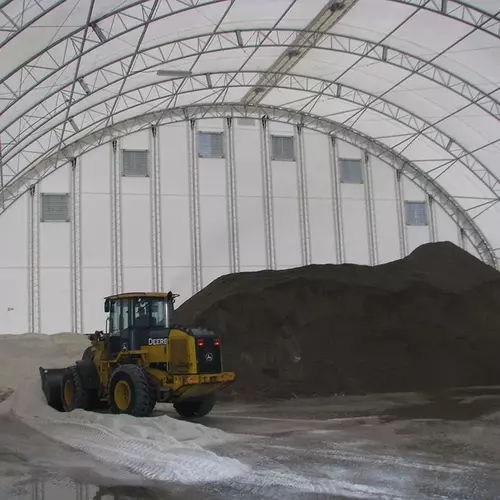Fabric Structures for Commercial Buildings
Commercial fabric buildings are designed to adapt seamlessly to your operational requirements, making them an ideal solution in the commercial sector. These structures support team productivity with their expansive, clear-span interiors, allowing for efficient use of space and workflow flexibility. In the commercial sector, MegaDome fabric structures stand out by offering rapid installation and a faster, more cost-effective alternative to conventional construction, helping businesses stay agile and competitive.
Quick Installation
MegaDome structures are built in a fraction of the time compared to traditional buildings, minimizing downtime and accelerating project completion, perfect for any commercial needs.
Customizable
With expansive, open floor plans and clear-span interiors, these commercial fabric buildings offer maximum flexibility for various applications, from warehousing to retail spaces.
Cost-Effective
Being more affordable and durable than conventional construction, MegaDome commercial fabric buildings offer a long-term value with lower upfront costs and maintenance expenses.

Applications of Fabric Buildings in Commercial Sectors
- Workshops
- Warehouses and Storage Facilities
- Aviation
- Fertilizer
Why choose MegaDome for commercial fabric structures?
MegaDome is the trusted choice for commercial fabric structures, offering unmatched durability, versatility, and customization. Our buildings are engineered with high-quality materials, including galvanized steel frames and UV-resistant fabric covers, ensuring long-term performance in even the most demanding environments. Whether you need a warehouse, retail space, or storage facility, MegaDome fabric buildings can be tailored to meet your specific needs with options for size, layout, and additional features. Designed for quick installation and low operational costs, our fabric buildings provide a cost-effective solution that adapts to the growing demands of your commercial enterprise.
FAQs about commercial fabric buildings
What commercial applications are fabric buildings suited for?
Fabric buildings are ideal for warehouses, retail spaces, event centers, distribution hubs, and equipment storage. Their clear-span interiors and flexible configurations make them suitable for a wide variety of commercial uses. They can easily be adapted or expanded as your business needs change.
Are fabric buildings durable enough for commercial use?
Yes, commercial fabric buildings are engineered with robust, galvanized steel frames and high-quality, weather-resistant fabric membranes. They are designed to withstand harsh climates, heavy snow loads, and high winds. Many structures remain in use for decades with minimal maintenance.
Can fabric buildings be customized to fit specific business needs?
Absolutely. Commercial fabric buildings can be tailored in terms of size, layout, door placements, ventilation, insulation, and even branding elements. For more details on available customization features, see our full range of building options. This level of customization ensures the building meets the unique operational requirements of each business.
What are the cost benefits of using fabric structures for commercial spaces?
Fabric structures are generally more cost-effective due to lower material costs, quicker installation, and minimal maintenance requirements. Businesses can save significantly on both initial construction and long-term upkeep. These savings contribute to a higher return on investment compared to traditional buildings.
How energy-efficient are fabric buildings for commercial use?
Because of their clear-span structures, commercial fabric buildings maximize natural daylight, reducing reliance on artificial lighting and cutting energy costs. They can also be insulated to maintain comfortable interior temperatures and minimize heating or cooling expenses. These features make them an environmentally friendly choice for commercial operations.
How long does it take to install a commercial fabric building?
Installation is much faster than with conventional buildings, often completed in just a few weeks depending on the size and complexity of the project. This speed helps minimize business downtime and allows for rapid expansion or relocation. Professional teams handle the entire process efficiently, from site preparation to final assembly.
